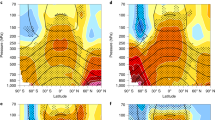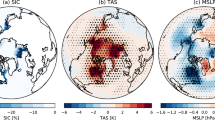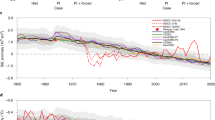Abstract
Surface air temperature over central Eurasia decreased over the past twenty-five winters at a time of strongly increasing anthropogenic forcing and Arctic amplification. It has been suggested that this cooling was related to an increase in cold winters due to sea-ice loss in the Barents–Kara Sea. Here we use over 600 years of atmosphere-only global climate model simulations to isolate the effect of Arctic sea-ice loss, complemented with a 50-member ensemble of atmosphere–ocean global climate model simulations allowing for external forcing changes (anthropogenic and natural) and internal variability. In our atmosphere-only simulations, we find no evidence of Arctic sea-ice loss having impacted Eurasian surface temperature. In our atmosphere–ocean simulations, we find just one simulation with Eurasian cooling of the observed magnitude but Arctic sea-ice loss was not involved, either directly or indirectly. Rather, in this simulation the cooling is due to a persistent circulation pattern combining high pressure over the Barents–Kara Sea and a downstream trough. We conclude that the observed cooling over central Eurasia was probably due to a sea-ice-independent internally generated circulation pattern ensconced over, and nearby, the Barents–Kara Sea since the 1980s. These results improve our knowledge of high-latitude climate variability and change, with implications for our understanding of impacts in high-northern-latitude systems.
This is a preview of subscription content, access via your institution
Access options
Subscribe to this journal
Receive 12 print issues and online access
$259.00 per year
only $21.58 per issue
Buy this article
- Purchase on Springer Link
- Instant access to full article PDF
Prices may be subject to local taxes which are calculated during checkout




Similar content being viewed by others
References
Hansen, J., Ruedy, R., Sato, M. & Lo, K. Global surface temperature change. Rev. Geophys. 48, RG4004 (2010).
Myhre, G. et al. in Climate Change 2013: The Physical Science Basis (eds Stocker, T. F. et al.) 659–740 (IPCC, Cambridge Univ. Press, 2013).
Comiso, J. C. Bootstrap Sea Ice Concentrations from Nimbus-7 SMMR and DMSP SSM/ISSMIS Version 2 (NASA National Snow and Ice Data Center Distributed Active Archive Center, 2000, updated 2015); http://dx.doi.org/10.5067/J6JQLS9EJ5HU
Cohen, J. et al. Recent Arctic amplification and extreme mid-latitude weather. Nat. Geosci. 7, 627–637 (2014).
Outten, S. & Esau, I. A link between Arctic sea ice and recent cooling trends over Eurasia. Climatic Change 110, 1069–1075 (2012).
Kug, J.-S. et al. Two distinct influences of Arctic warming on cold winters over North America and East Asia. Nat. Geosci. 8, 759–762 (2015).
Screen, J. A. & Simmonds, I. The central role of diminishing sea ice in recent Arctic temperature amplification. Nature 464, 1334–1337 (2010).
Overland, J. E. & Wang, M. Large-scale atmospheric circulation changes are associated with the recent loss of Arctic sea ice. Tellus A 62, 1–9 (2010).
Inoue, J., Hori, M. E. & Takaya, K. The role of Barents sea ice in the wintertime cyclone track and emergence of a warm-Arctic cold-Siberian anomaly. J. Clim. 25, 2561–2568 (2012).
Overland, J. E., Wood, K. R. & Wang, M. Warm Arctic-cold continents: climate impacts of the newly open Arctic Sea. Polar Res. 30, 15787 (2011).
Francis, J. A., Chan, W., Leathers, D. J., Miller, J. R. & Veron, D. E. Winter Northern Hemisphere weather patterns remember summer Arctic sea-ice extent. Geophys. Res. Lett. 36, L07503 (2009).
Tang, Q., Zhang, X., Yang, X. & Francis, J. A. Cold winter extremes in northern continents linked to Arctic sea ice loss. Environ. Res. Lett. 8, 014036 (2013).
Honda, M., Inoue, J. & Yamane, S. Influence of low Arctic sea-ice minima on anomalously cold Eurasian winters. Geophys. Res. Lett. 36, L08707 (2009).
Mori, M., Watanabe, M., Shiogama, H., Inoue, J. & Kimoto, M. Robust Arctic sea-ice influence on the frequent Eurasian cold winters in past decades. Nat. Geosci. 7, 869–873 (2014).
Kim, B.-M. et al. Weakening of the stratospheric polar vortex by Arctic sea-ice loss. Nat. Commun. 5, 4646 (2014).
Petoukhov, V. & Semenov, V. A. A link between reduced Barents-Kara sea ice and cold winter extremes over northern continents. J. Geophys. Res. 115, D21111 (2010).
Arora, V. K. et al. Carbon emission limits required to satisfy future representative concentration pathways of greenhouse gases. Geophys. Res. Lett. 38, L05805 (2011).
Sigmond, M. & Fyfe, J. C. Tropical Pacific impacts on cooling North American winters. Nat. Clim. Change 6, 970–974 (2016).
Deser, C. et al. Communication of the role of natural variability in future North American climate. Nat. Clim. Change 2, 775–779 (2012).
Flato, G. et al. in Climate Change 2013: The Physical Science Basis (eds Stocker, T. F. et al.) 741–866 (IPCC, Cambridge Univ. Press, 2013).
Peings, Y. & Magnusdottir, G. Response of the wintertime Northern Hemisphere atmospheric circulation to current and projected Arctic sea ice decline: a numerical study with CAM5. J. Clim. 27, 244–264 (2014).
Screen, J. A., Deser, C., Simmonds, I. & Tomas, R. Atmospheric impacts of Arctic sea-ice loss, 1979–2009: separating forced change from atmospheric internal variability. Clim. Dynam. 43, 333–344 (2014).
Deser, C., Sun, L., Tomas, R. A. & Screen, J. Does ocean coupling matter for the northern extratropical response to projected Arctic sea ice loss? Geophys. Res. Lett. 43, 2016GL067792 (2016).
Horton, D. E. et al. Contribution of changes in atmospheric circulation patterns to extreme temperature trends. Nature 522, 465–469 (2015).
Dee, D. P. et al. The ERA-Interim reanalysis: configuration and performance of the data assimilation system. Q. J. R. Meteorol. Soc. 137, 553–597 (2011).
Compo, G. P. et al. The twentieth century reanalysis project. Q. J. R. Meteorol. Soc. 137, 1–28 (2011).
Takaya, K. & Nakamura, H. Mechanisms of intraseasonal amplification of the cold Siberian high. J. Atmos. Sci. 62, 4423–4440 (2005).
Kay, J. et al. The Community Earth System Model (CESM) large ensemble project: a community resource for studying climate change in the presence of internal climate variability. Bull. Am. Meteorol. Soc. 96, 1333–1349 (2015).
Sorokina, S. A., Li, C., Wettsten, J. J. & Kvamstø, N. G. Observed atmospheric coupling between Barents Sea ice and the Warm-Arctic Cold-Siberia anomaly pattern. J. Clim. 29, 495–511 (2016).
von Salzen, K. et al. The Canadian fourth generation atmospheric global climate model (CanAM4). Part I: representation of physical processes. Atmos. Ocean 51, 104–125 (2013).
Screen, J. A., Simmonds, I., Deser, C. & Tomas, R. The atmospheric response to three decades of observed Arctic Sea ice loss. J. Clim. 26, 1230–1248 (2013).
Rayner, N. A. et al. Global analyses of sea surface temperature, sea ice, and night marine air temperature since the late nineteenth century. J. Geophys. Res. 108, 4407 (2003).
Merryfield, W. J. et al. The Canadian seasonal to interannual prediction system. Part I: models and initialization. Mon. Weath. Rev. 141, 2910–2945 (2013).
Acknowledgements
We acknowledge Environment and Climate Change Canada’s Canadian Centre for Climate Modelling and Analysis for executing and making available the CanESM2 large ensemble simulations used in this study, and the Canadian Sea Ice and Snow Evolution (CanSISE) Network for proposing the simulations. K.E.M. was supported by the CanSISE Network, which is funded by the Natural Science and Engineering Research Council of Canada (NSERC) under the Climate Change and Atmospheric Research (CCAR) programme. We thank N. Swart and B. Merryfield for helpful comments on the manuscript.
Author information
Authors and Affiliations
Contributions
K.E.M. and J.C.F. conceived of the project and experiments and wrote the manuscript. M.S. provided guidance on the experiments and helped write the manuscript.
Corresponding author
Ethics declarations
Competing interests
The authors declare no competing financial interests.
Supplementary information
Supplementary Information
Supplementary Information (PDF 2944 kb)
Rights and permissions
About this article
Cite this article
McCusker, K., Fyfe, J. & Sigmond, M. Twenty-five winters of unexpected Eurasian cooling unlikely due to Arctic sea-ice loss. Nature Geosci 9, 838–842 (2016). https://doi.org/10.1038/ngeo2820
Received:
Accepted:
Published:
Issue Date:
DOI: https://doi.org/10.1038/ngeo2820
This article is cited by
-
Response of winter climate and extreme weather to projected Arctic sea-ice loss in very large-ensemble climate model simulations
npj Climate and Atmospheric Science (2024)
-
Relative Impacts of Sea Ice Loss and Atmospheric Internal Variability on the Winter Arctic to East Asian Surface Air Temperature Based on Large-Ensemble Simulations with NorESM2
Advances in Atmospheric Sciences (2024)
-
Interannual variation of the Warm Arctic–Cold Eurasia pattern modulated by Ural blocking and the North Atlantic Oscillation under changing sea ice conditions
Progress in Earth and Planetary Science (2023)
-
Ocean fronts as decadal thermostats modulating continental warming hiatus
Nature Communications (2023)
-
Arctic-associated increased fluctuations of midlatitude winter temperature in the 1.5° and 2.0° warmer world
npj Climate and Atmospheric Science (2023)



